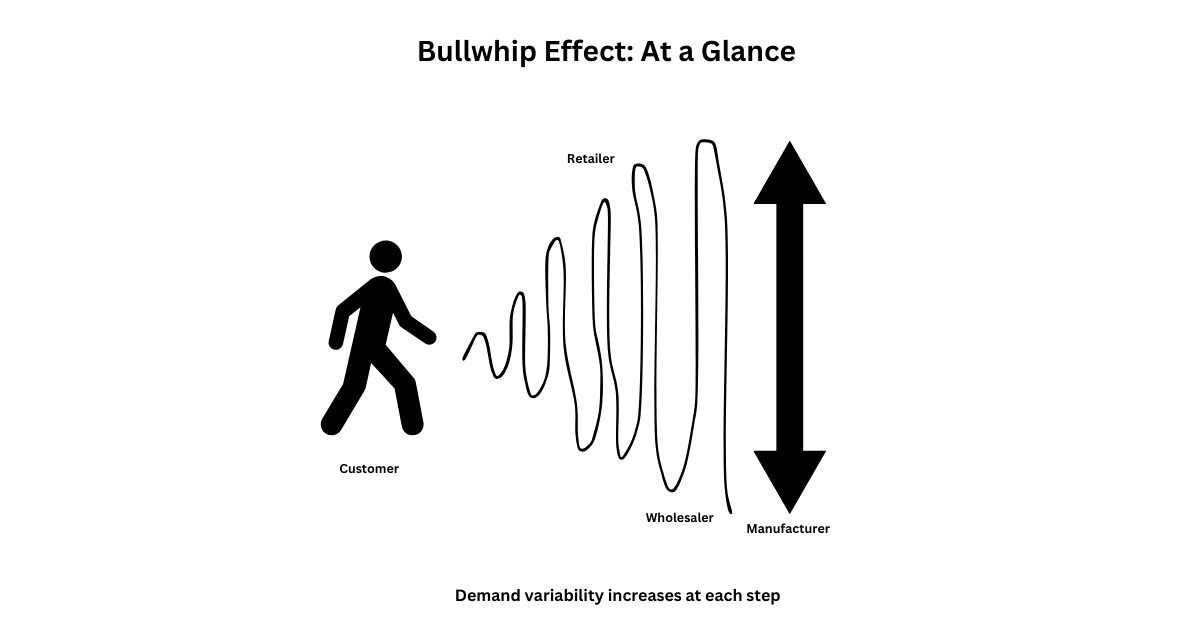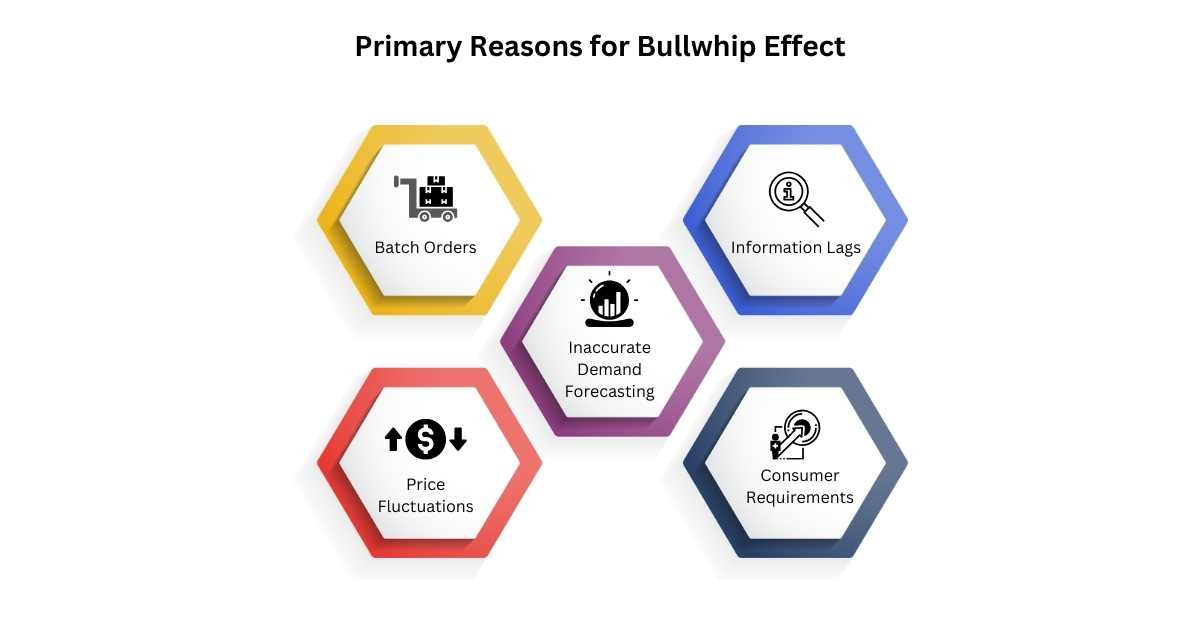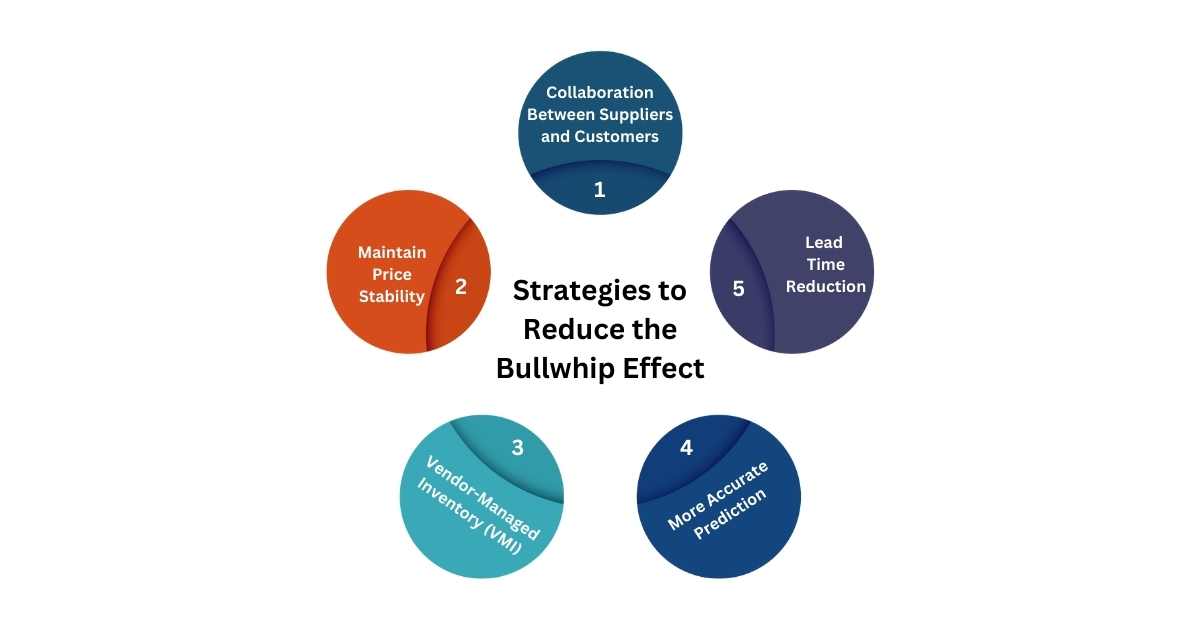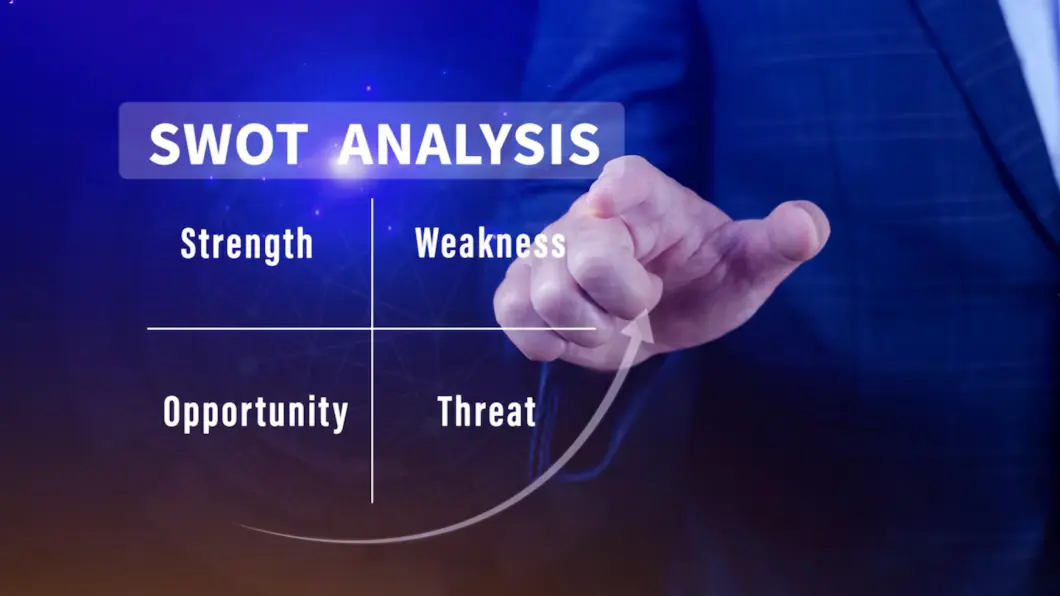What is the Bullwhip Effect in Supply Chain Management?
Bullwhip effect in supply chain management is a phenomenon where a small variation in demand at the customer level leads to larger fluctuations in order sizes at the supply side, resulting in supply chain inefficiencies and inventory stockpiling or shortage, thus impacting customer service and delivery.
If a downstream supplier overestimates demand, the suppliers upstream react in anticipation of higher demand, leading to a ripple effect throughout the supply chain, and vice-versa. The bullwhip effect is often a consequence of inaccurate forecasting, delays in information sharing and inconsistent order placements.
Example of the Bullwhip Effect
Bullwhip effect in supply chain example can be best explained with a case of smartphone sales during the pandemic. The demand for smartphones rose suddenly as children were attending online classes. When a retailer sold 100 phones weekly, the wholesaler sensed higher demand signals and ordered 1000 phones. On anticipating higher demand from wholesalers, the distributor stocks 10,000 phones.
The manufacturer, completely surprised by the increased order size from one distributor, anticipates rapid surge in demand and expands production capacity to produce 1,00,000 phones per month. But as the demand starts receding, the manufacturers and suppliers are left with excess inventory, as they were too late to track the actual demand pattern.
More recently, the World Bank’s trade watch report noted a rising stress in global supply chains as shipping rates more than doubled in a year, as published in the Indian Express. Amid such supply chain uncertainties, suppliers may maintain extra stock for certain items and order more from their vendors. Meanwhile, customer preferences can change, leading to a mismatch between supply and demand.
Therefore, a bullwhip effect in a supply chain is often a result of information lags and it commonly occurs when manufacturers overreact to changes in demand and make inaccurate forecasting decisions, especially when they lack a foolproof system like a manufacturing ERP software that can help them closely track demand, plan production and optimize inventory levels.
How the Bullwhip Effect Impacts Supply Chain?
The bullwhip effect can have a profound impact on your supply chain.
1. Irregular Inventory Practices
There can be dramatic shifts in inventory levels in your plant warehouse, more so when you don’t have an inventory management software. Excess of one item and extreme shortage of another.
2. Faulty Production Plans
Excessive inventory build up may throw your production plans off the track. Your procurement decisions may be inaccurate. You may even find it difficult to set order priorities, leading to customer distress.
3. High Operational Costs
As you get into firefighting mode to meet the shortage of one product, you run extra production shifts, which increases your cost of operation, including transportation and inventory holding costs.
4. Inefficient Supply Chain
Suppliers across the supply chain may find it difficult to deliver orders on time, which impacts your ability to service customers due to higher lead times, and your competitors take advantage of this.
5. Weak Supplier Relationship
Not aware of your production plans, your suppliers may ration their supply and look for other stable customers. Growing misunderstanding leads to tension and a lack of trust between parties.
Also Read: What is Supplier Relationship Management?
Why the Bullwhip Effect Happens?
Now, let’s explore the various causes of the bullwhip effect.
1. Inaccurate Demand Forecasting
With rapid shifts in customer preferences, traditional business tools just can’t keep up with changes in demand, leading to demand forecasting errors. However, if you implement some of the best ERP software in India in your business, you can significantly enhance demand forecasting accuracy.
2. Batch Orders
To save logistics cost, it is a common practice among supply chain partners to place orders in large batches in full truck loads and as and when needed. Fixed order interval system is one way to counter this problem where frequent orders at regular intervals reduces fluctuations in demand.
3. Price Fluctuations
Driven by the need to offload excess raw material inventory, some suppliers may produce and sell their finished goods inventory at a surprisingly low price which creates an artificial demand for other raw materials. However such variability in prices leads to inefficient supply chains.
4. Information Lags
One of the key factors contributing to the bullwhip effect is the lack of communication among supply chain partners about the actual demand. This lack of transparency is often motivated by the need to maintain trade secrecy, which hinders true collaboration that modern ERP applications can bring.
5. Consumer Requirements
Shifting customer preferences and purchasing habits may find suppliers constantly trying to catch up with demand through frequent changes in resource allocation. Overestimation or underestimation of demand at one level of the supply chain leads to higher fluctuations throughout the supply chain.
What are the Signs of the Bullwhip Effect?
It is vital to look for the signs of the bullwhip effect in a supply chain so that you can reduce the impact of the bullwhip effect on your business. Comparing historic sales data, demand forecasts, and order patterns across different levels of the supply chain using ERP solution helps in keeping track of order variability and inventory turnover rates, thereby pinpointing the bullwhip effect early.
Here are some important signs to look for:
1. Fluctuating Order Volume
Alarm bells should sound for a chemical manufacturer where his ERP for chemical manufacturing identifies high standard deviation in month-on-month demand from multiple customers.
2. Elevated Stock Levels
On reviewing inventory levels in your warehouse management system, if you find excessive stock in certain product categories vis-à-vis the orders, perhaps your sales forecasting model is flawed.
3. Frequent Stock-outs
Do you often find your shop floor run out of the fast-moving inventory essential to your production? This is a sign that your suppliers are unable to keep up with your erratic order patterns.
4. Demand Distortion
The onset of seasonal flu may lead to temporary spike in OTC drugs sale. Without a pharma ERP software, there could be a mismatch between actual demand than what is recorded in the supply chain.
5. Long Lead Times
Majority of your suppliers are asking for more than usual time to deliver your orders. Have they lately become unsure of what you would be needing, when you would be needing and in what quantity?
6. Unusual Promotions
To capture market share, the local grocery chain may offer unusual discounts on your high-selling food product. Sensing an opportunity, the suppliers across the chain misread the demand signals.
You Might Also Like: What are the Top 10 Techniques of Material Control?
How to Minimize the Bullwhip Effect in Supply Chain?
Now that you know why the bullwhip effect occurs, let’s find out what you can do to minimize it.
1. Collaboration Between Suppliers and Customers
Transparency between suppliers and customers goes a long way in building trust among parties. One of the effective techniques to boost collaboration is CPFR (Collaborative Planning, Forecasting, and Replenishment) where vendors and customers openly share information on sales data, demand forecasts, real-time inventory levels via cloud ERP to ensure that products are available to customers when they need them.
2. Vendor-Managed Inventory (VMI)
Another effective method to mitigate the bullwhip effect is the concept of vendor-managed inventory, where the vendor takes decisions on when to restock the customer inventory. As a result, vendors gather a lot of information from customers, such as inventory levels, reorder points, consumption rates and shelf-life monitoring. ERP implementation gives them real-time demand visibility with integration of technologies such as Electronic Data Interchange(EDI), Point of Sale (POS), and IoT sensors.
3. More Accurate Prediction
Advanced data analytics features in ERP software can identify trends and patterns and make predictions based on a large number of factors, such as historic sales, market trends, external factors like economic conditions and social media sentiment. Even weather conditions, like the monsoon progress and intensity can be tracked using AI in supply chain for improving accuracy of prediction and make more informed production decisions.
4. Lead Time Reduction
Focus on reducing lead time by adopting demand-driven strategies such as Just-in-Time inventory system where the inventory is ordered in small batches only when it is needed for production. This helps you align your production with real-time customer demand. When you adopt such agile and lean manufacturing practices, the demand variability decreases and the inventory replenishment rate increases while eliminating the need for long-term demand forecasting.
5. Maintain Price Stability
Imagine what would happen when a supplier of auto parts is offering his products at reduced rates to the automobile OEM for the next six months to build relationship. Receiving a better bargain, the OEM will order more to stock inventory. The suppliers upstream will suddenly receive a huge order and their next demand forecasting will be based on the higher order size as they are not aware of the real reason of the demand spike. Thus, suppliers should avoid dramatic price variations to prevent disruptions later.
Take Complete Control of Your Supply Chain with Sage X3
Bullwhip effect has long troubled the manufacturers. Knowing why it happens and what you can do to mitigate its impact can help you implement long-term solutions. Information sharing among partners stands out as an important mitigation strategy that helps everybody align on the actual demand from customers, thereby enhancing customer satisfaction and reduction in lead time.
In a world where supply chain disruptions have become commonplace, having a sturdy ERP software like Sage X3 revolutionizes how you manage your supply chain from vendors to customers. With its innovative ERP solution addressing a range of supply chain challenges like the bullwhip effect, Sage X3 not just enhances operational efficiency but also sets new standards in supply chain management.
FAQ
1. How Does Consumer Behavior Contribute To The Bullwhip Effect?
Consumer behavior, like sudden increases in demand or preference shifts, can prompt suppliers to overestimate demand, leading to larger fluctuations as orders move up the supply chain.
2. Why Do Long Lead Times Amplify The Bullwhip Effect?
Long lead times delay demand information from reaching suppliers, causing over-adjustments in production and inventory levels as companies try to catch up to perceived demand changes.
3. What Role Does Order Batching Play In The Bullwhip Effect?
Companies often place bulk orders to save on costs, but these large, irregular orders lead to distorted demand signals, which intensify as they move up the supply chain.
4. How Does Price Fluctuation Affect The Bullwhip Effect?
Temporary price discounts or promotions can create spikes in demand, which distort normal purchasing patterns, leading suppliers to overstock and then face inventory issues when demand normalizes.
5. Are There Any Specific Industries More Vulnerable To The Bullwhip Effect?
Industries with unpredictable demand, such as fashion or electronics, are more vulnerable due to frequent shifts in consumer preferences and shorter product life cycles, which heighten demand variability across the supply chain.










